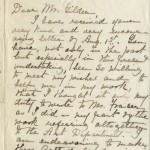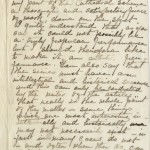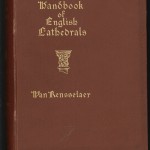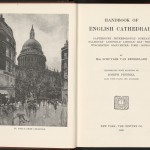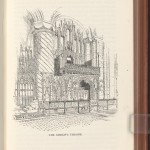Biographer Judith Major’s recent book Mariana Griswold Van Rensselaer: A Landscape Critic in the Gilded Age (University of Virginia Press) highlights the work of the pioneering landscape critic, and Major quotes from one of the letters in the Ransom Center’s Elizabeth and Joseph Pennell papers for her book. Joseph Pennell (1857–1926) was one of America’s premier etchers and illustrators. He found a commercial success as a magazine illustrator, turning out well-received renderings of American and, later, European scenes.
The Pennell collection includes correspondence that documents a notable creative project undertaken by Joseph Pennell (1857–1926) and Mariana Van Rensselaer (1851–1934) in which they published illustrated articles on the cathedrals and churches of England and France. Their two series of illustrated articles appeared in issues of The Century Magazine between 1887 and 1899; the first series, English Cathedrals, was issued in book form in 1892.
In 1882, when the idea for the articles on the cathedrals of England was first conceived by Van Rensselaer, she had been a published author and critic on art, architecture, and landscape architecture for six years. Pennell had been working as an illustrator, first in his native Philadelphia and then nationally, since the late 1870s. He had done illustrations in Scribner’s Magazine, Century, and other publications. His best-known work at that point was the illustrations he executed to accompany George Washington Cable’s text for The Creoles of Louisiana, issued serially in The Century Magazine during 1883 and published in book form in 1884.
Van Rensselaer likely invited Joseph Pennell to provide the illustrations for her English cathedral articles because both Van Rensselaer and the Century’s editor, Richard Watson Gilder, knew and respected Pennell’s work. In 1884, Pennell was living in London, married to Elizabeth Robins, a writer and fellow Philadelphian.
The work on the English cathedrals got off to a rocky start when, in the summer of 1885, Van Rensselaer, returning to New York from Germany, stopped in York, England, expecting to meet with Pennell. Pennell didn’t appear or account for his absence, and when later they were able to meet, he related to his wife, Elizabeth, “his frank impressions of Mrs. Van Rensselaer, who had ideas for the cathedral [at Salisbury] which were not his.” Despite this initial awkwardness the English cathedral series was completed “without unpleasantness” (in Elizabeth Pennell’s words), and the final article published in The Century Magazine by 1889.
As Pennell began his work on the churches of France in the fall of 1889, a new source of discord between artist and writer made itself evident. Pennell had begun working with churches in the south of France when he discovered several of those chosen for illustration had undergone recent restoration or were currently under restoration. This situation and the artist’s response to it had a significant impact upon his choices of subjects and the drawings he sent back to New York.
In a long letter Van Rensselaer wrote to W. Lewis Fraser of the Century art department on January 30, 1890, she reviewed Pennell’s drawings, and while on the whole she was pleased, she found problems with the cathedrals in Angoulême and Périgueux and the St. Sernin church in Toulouse.
Pennell had not supplied exterior views of any of the three that she found acceptable. Of St. Sernin she wrote “In some way or the other I must have at least one picture of the exterior of the church; if not from Mr. Pennell, then drawn by someone else from a photo.” In other cases Pennell had supplied views she hadn’t asked for; several of these she had turned down as “entirely useless for my purpose.”
In this file there is a six-month hiatus until the next piece of surviving correspondence. This was Mariana Van Rensselaer’s letter of July 31, 1890 to editor R. W. Gilder in which she responded to Joseph Pennell’s “recent letters to Mr. Fraser.”
Van Rensselaer opened with the comment that “I am sorry he finds some of the buildings in question ‘unillustrate-able’…” and goes on to assert that “ they are unrivalled in historical and, I venture to say, in broad and deep architectural (which means artistic) interest.”
Further along in the letter she notes that her choices of subject were intended to illustrate the significant regional variation seen in medieval French ecclesiastical architecture and, for this reason, “we must have the great typical buildings, however restored, and not less typical unrestored ones, or attractive bits gathered here and there.”
In Pennell’s letters he referred to his practice of using shading and other effects to ameliorate the problems posed by unsympathetic restoration and unfinished repairs, provocatively referring to this process as “cooking.” Van Rensselaer responded by observing that he had been “engaged to illustrate what he saw, not to make fancy sketches.” Later in the letter, however, she modified her position, stating the hope that Gilder “will give me the privilege of rejecting any that are ‘cooked’ in too palpable a way.”
Van Rensselaer’s 12-page response to Pennell was supplemented by a briefer letter from Gilder to the artist. In it he stated that The Century Magazine regarded the series as “an intellectual & historical” work “conducted by the writer of the articles” and that the magazine had “surely endeavored to meet your views in every way.” Gilder closed with the observation that the series upon that Pennell and Van Rensselaer labored was not, commercially speaking, a “hilariously ‘popular’ performance,” but one which demanded “great exertions and no little drudgery on the parts of both writer & artist.”
In his reply from Luchon, France, dated August 20, 1890, Pennell responded to Gilder’s letter by once again stating the impossibility of making tangible the intent of the original builders of the churches when they had been unsympathetically restored. “I can look beneath the restoration but Mrs. Van Rensselaer should remember that I must draw what is on the surface. [Henry Hobson] Richardson [whose sympathetic description of the churches had been mentioned by Van Rensselaer earlier] would never have dreamed of taking the modern restoration of St. Sernin as anything but a model of very ordinary work of the most uninteresting kind.”
Pennell defended “my cooking or faking … [of] these drawings [by asserting] when I come to one of these old churches … and find, instead of beautiful stained glass which ought to be there, blank white windows, or windows at times which are even yet unfinished … I have got to intensify, for example, my lights and shadows and try to give some sort of pictorial effect which really is not there.”
Pennell concluded his reply with the statement that “I never should think of criticizing Mrs. Van Rensselaer’s scheme or methods, but I cannot help repeating that she ought to bear in mind that I cannot draw the ideas of the old men when their work is not visible.”
The last item in the Pennell-Van Rensselaer correspondence file is Van Rensselaer’s letter of August 13, 1893 to Joseph Pennell, and its tone is in marked contrast to the preceding letters in the file. Having just returned to Marion (where she was living) from “that extraordinary and enchanting [World’s] Fair at Chicago,” she recounts her work rewriting the English cathedral book (by now entitled Handbook of English Cathedrals) and makes suggestions for Pennell’s work at Bourges, Le Mans, Chartres, and Le Puy. In closing, Van Rensselaer returns to the world’s fair, writing “I suppose you will come home to see the Fair. If not, you will miss the great sight of the century.”
Mariana Van Rensselaer withdrew from the project before the fourth article in the French cathedral series appeared in the September 1899 issue of The Century Magazine. Since Pennell had finished drawings on hand, the editors of the magazine asked Elizabeth Pennell to write the articles, allowing the series to be completed between 1907 and 1909. The cathedrals of Amiens, Beauvais, and Rouen concluded the project; these three were the only edifices in the series that Joseph Pennell etched on site.
Please click the thumbnails to view full-size images.


